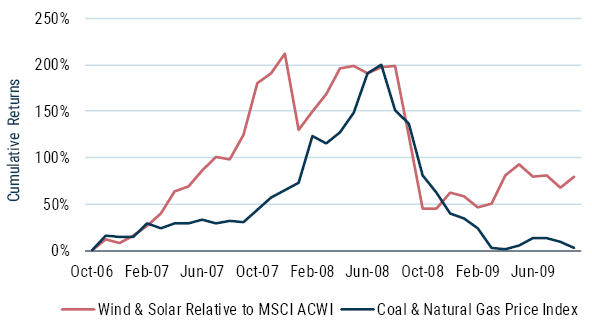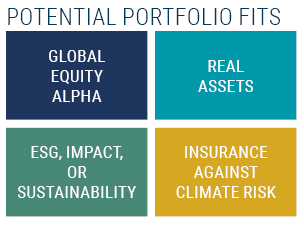Key Points
- We believe the secular growth tailwinds in the climate change sector will provide investors with strong investment opportunities for decades to come.
- In our opinion, a well-designed climate change strategy can provide investors with a variety of benefits, including diversification, protection from climate risk, inflation protection, and the ability to invest in growth-oriented companies at a discount.
- For those considering fossil fuel divestment, clean energy solutions provide indirect exposure to fossil fuel prices.
- A climate change strategy can play an important role in a global equity program, real asset program, ESG portfolio, or as climate risk insurance.
Introduction
Hurricanes, typhoons, droughts, wildfires, and other extreme weather events are causing record damage. Increasingly, climate change is impacting the economy and our daily lives and has come into focus as an existential threat to the world as we know it.1 We are rapidly approaching a time when the world will be forced to act aggressively in an attempt to overcome decades of inaction. As return-oriented investors, we see this effort providing the backdrop for decades of secular growth in the climate change sector, along with the potential for strong returns.2
Beyond strong returns, we believe a climate change strategy (for our purposes, a strategy investing in the sector) may offer other significant benefits as well. We expect these to include diversification, protection from climate risk, inflation protection, and the potential to buy growth-oriented companies at a discount. However, excitement about these desirable characteristics can be tempered by uncertainty regarding how to position a climate change strategy in the context of a broader portfolio. In this paper, we will explore these benefits in more detail and also discuss how such a strategy may fit into an investment portfolio.
Expected Benefits of a Climate Change Strategy
In our 2017 paper, we made the case that the climate change sector will experience decades of secular growth. The global energy infrastructure is incredibly vast and complex and has been built up over more than 150 years. Transitioning to clean energy will take a tremendous amount of investment and time. Many trillions of dollars will be needed to decarbonize the economy and overhaul our energy grids. Experts project investments in renewables alone to approach $2 trillion per year by 2050.3
We also made the case that the climate change sector is likely to be relatively inefficient with opportunities to add significant value. Given the secular growth tailwinds and the inefficiencies to be exploited, we believe that investors who do a good job of identifying the winners in the fight against climate change will be handsomely rewarded. In addition to strong returns, we have other expectations for a climate change strategy that are worth considering, as they will better allow us to think about how such a strategy might fit into a broader portfolio.
Diversification
We would expect the drivers of return for a climate change strategy to be quite different from those of the broad equity market. Broad economic profitability and GDP growth will not drive a climate change strategy; the clean energy transition and efforts to decarbonize will. Thus, we expect to see periods where a climate change strategy performs well in a weak market and vice versa.
If we told you we had identified an asset class that provided equity-like returns, perhaps better, in a manner quite different from the broad equity market, you would jump at the opportunity. After all, hedge fund investors typically accept low returns, high fees, and illiquidity in the quest for uncorrelated returns. We believe climate change investors will be able to enjoy the benefits of diversification without making such sacrifices.
Protection from Climate Risk
Diversification, in and of itself, is compelling. Diversification that addresses a major risk to the broad economy is even more so. The Trump Administration’s Fourth National Climate Assessment concluded that climate change “is expected to cause substantial…damage to the U.S. economy throughout this century.” If climate change is a drag on the economy, companies focused on mitigation will see their products and services in high demand. Furthermore, as the world moves to decarbonize, regulation and carbon taxes loom as a risk for virtually all sectors. Green energy industries, however, will uniquely benefit from increased government intervention, not to mention from the ever-improving technology.
Indirect Exposure to Fossil Fuel Prices & Inflation Protection
Many investors have divested or are considering divestment from fossil fuels. Complicating these decisions is the fact that energy companies have outperformed the broad equity market and provided inflation protection and diversification (e.g., in the 1970s, oil & gas companies were up well over 100% in real terms with the S&P 500 down, a scenario that played out again from 2000 to 2010). Outperformance, diversification, and inflation protection are pretty big things to give up.
Fortunately, by investing in the clean energy solutions that compete with fossil fuels, one can maintain that exposure to traditional energy prices. When fossil fuel prices rise, clean energy solutions become more competitive, and market forces accelerate the transition to them. Of course, the same is true on the downside. This connection between fossil fuel prices and clean energy returns could be seen in 2008 (see Exhibit 1) when oil spiked to $150 per barrel and coal and natural gas prices also soared. Solar and wind companies performed extremely well leading up to the peak in fossil fuel prices and then collapsed as fossil fuel prices came back down to earth. Another example of the connection between clean energy solutions and fossil fuel prices surfaced in 2015 following a dramatic drop in oil prices. Electric vehicle sales in the U.S., otherwise in the midst of rapid growth, actually fell, as the economics surrounding gasoline improved.
Exhibit 1: Clean Energy Solutions Provide Indirect Exposure to Fossil Fuel Prices

Source: MSCI, Global Financial Data, GMO
Just as our traditional energy infrastructure relied on fossil fuels, clean energy relies on materials. Transitioning to clean energy simply moves the burden from fossil fuels to copper, lithium, nickel, cobalt, and other materials. Because of the indirect exposure to fossil fuel prices and direct exposure to clean energy materials, agriculture, water, and infrastructure, we believe the climate change sector, as we’ve defined it, will perform well in certain inflationary environments.
Growth at a Discount
To this point in the paper, we’ve focused on the features of generic climate change strategies (to the extent that there are any), but our strategy, more specifically, is to attempt to identify companies that trade at a discount but still benefit from the secular growth tailwinds we’ve been discussing. Typically, value strategies undergrow the market; after all, the companies are cheap for a reason. What a value investor hopes for is multiple expansion that more than offsets the undergrowth. When investing in a high growth sector of the market like climate change, however, you may be able to buy companies at a discount that are able to grow with, or potentially outgrow, the market. Since inception in April 2017, the earnings growth of the GMO Climate Change Strategy has been higher than the MSCI All Country World Index (ACWI) while consistently trading at a 15-20% discount to ACWI. If we can continue to own a portfolio of companies trading at a discount without sacrificing growth, we believe we can generate strong performance over the long term.
Portfolio Fit
The prospects for strong returns, diversification, and inflation protection are exciting, but how does a climate change strategy fit into a broader portfolio? After all, very few investors have a climate change bucket! There are a few different ways of framing this sort of allocation. Our favorite framing is to position as a global equity alpha play with diversification benefits. We believe there’s money to be made in this sector. What more do you need?

Outside of global equities, the most natural home for a climate change strategy for many portfolios may be in the real assets allocation. There’s also a growing trend toward making specific allocations to ESG, impact, and sustainable investments.4 Clearly, a climate change strategy would be a candidate for these types of allocations or for investors who favor thematic investing more generally.
Perhaps the most interesting framing, however, may be to think of this type of strategy as insurance. As already discussed, the experts expect climate change to have a major impact on the economy. Even with the uncertainty surrounding such projections, one must acknowledge that there’s a significant risk that climate change will have a considerable, unpleasant economic impact. It seems reasonable to think that investors would want to protect themselves from this risk, and investing in a climate change strategy would be a good start.
Conclusions
Allocating to a climate change strategy is not standard operating procedure for investors, but for those willing to think outside the box, we expect the rewards to be significant. Not only should investors be intrigued by the potential for returns, diversification, and inflation protection, but a well-designed climate change strategy should also help protect a portfolio from a major risk to the economy. There are a variety of ways that such a strategy could fit into a portfolio. It’s up to investors to figure out how a climate change strategy fits into their particular investment process, but we expect it will be worth the effort.
Download article here.

